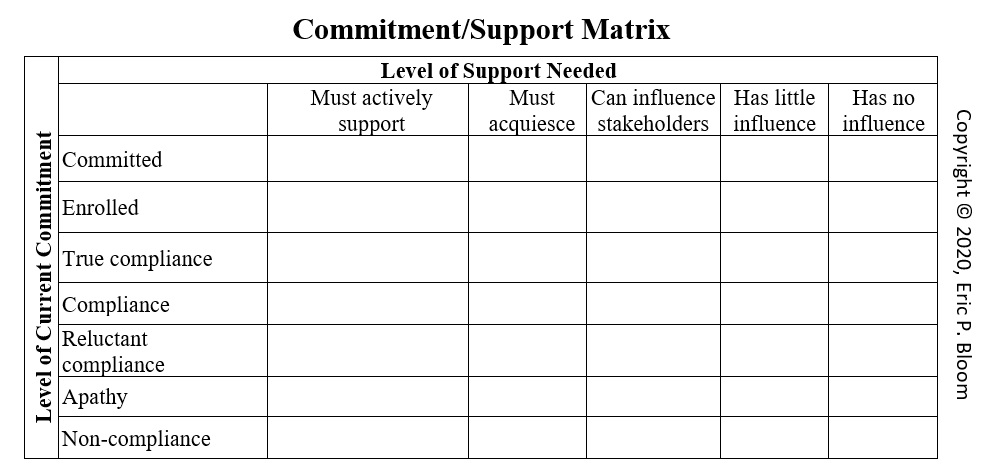The ability to influence your coworkers is, of course, a very important skill. To maximize its effectiveness, however, you must also know whom to influence. The strategic ability to decide who, where, and when to influence allows you to prioritize your time, carefully use your political capital, and not accidently wear out your welcome.
To this end, the following worksheet (Figure 1) illustrates the intersection of people’s commitment to your vision/project and the importance of their approval to your success. It is this intersection of commitment and need that defines the prioritization of those who must be influenced to meet your business objectives.
Enter the necessary names into the appropriate intersecting cells on the Commitment/Support Matrix (Figure 1) based upon their current commitment and your need. This gives you a visual representation of where to spend your influence-related energies.
The definition of each of the matrix values is listed below:
Levels of Commitment to Your Objective
The following describe people’s various levels of commitment toward your project goal.
Committed: An advocate of your project
These people are great to have on your team because they believe in what you are trying to do and will provide whatever assistance is needed to help you succeed. However, it is important to know why they support you because you want to feed their enthusiasm to ensure they stay committed to your cause. You also must be very careful not to do anything that contradicts the reason for their support. The loss of a strong and visible advocate of your project can cause others to question their own support, particularly if this person is highly respected by your other supporters.
Enrolled: Will invest time to help facilitate your project’s success
These people will provide assistance, support, and funding when asked, but your project will not be a top priority. These could be people who generally support your work, have a small vested interest in your project, or think your project is good for the company and, therefore, merits their support.
True compliance: Willing to comply with the spirit of your project
These people will follow instructions and wish you well. They may also provide you with input and suggestions, if asked. Their willingness to happily comply may be for one of the following reasons:
- They like you and want to be of help.
- They agree that the initiative will be good for the organization and, thus, want to participate.
- They think the initiative will be good for them and provide personal advantage.
- They have a high respect for authority and will follow directions if asked.
Properly understanding the “who” behind their willingness to comply gives you insight into how to potentially elevate their support to enrolled or committed.
Compliance: Will do what is required without complaint
Those falling into this category believe that your project will cause them neither pleasure nor pain. As a result, they see no benefit or risk in following your request. The danger of people in this category is they are more likely to drop down toward noncompliance than up toward commitment. You want to gently move them toward your goal without pushing them too hard or causing them any difficulty.
Reluctant compliance: Will do the minimum to avoid trouble
People with this attitude toward your project have no vested interest in your work or you in general. Although they don’t wish you harm, they will not do any more than the minimum required. This level of commitment from a single individual is generally not an issue. However, if you need their support or their team’s resources, their stance can easily become problematic.
Apathy: Does not care about you or your project, but will do as they are told
As the title of this category suggests, people who are apathetic toward you or your project are putting forth a quiet reluctance. At best, they want no involvement or connection to your project; at worst, they will block your way through a combination of inaction and unfulfilled promises.
Noncompliance: Will not comply with your requests and will actively work to undermine you
These people want your project to fail. The reason behind this animosity could be personal, but it is more likely that there is something about your project they dislike for one of the following reasons:
- They conceptually believe you are moving in the wrong direction.
- They feel your success will hurt them in some way, such as reduced income, lower professional stature, or stunted career growth.
- They have a personal or departmental goal that is in direct conflict with what you are trying to accomplish. Thus, if you are successful, their project will be hurt.
If there are people within your company who fall into this noncompliance category, your first step is to understand the reason behind their noncompliance. Upon doing so, one of the following plans of action may be of value:
- Listen to why they disagree with you. If they think you are going in the wrong direction, maybe you are and have not seen it. Be flexible if they are right.
- If you do not believe your project will be a problem for them, have a discussion with them to address their concerns. You may be able to find middle ground with an acceptable compromise.
- If you cannot reach an agreement, at least try to “agree to disagree” on direction and principle. Then attempt to find a way you can both move forward without hurting each other’s interests.
Required Levels of Support by Specific Individuals
Whereas the level of commitment measures the willingness of people to support your project, the level of need measures the importance of their support in moving your project forward. In effect, the commitment level is what they think of you, and the level of need is what you think about them.
Must actively support: Without full commitment, your project will fail
The support of these people is essential for you to be successful. Your project will fail without their approval, resources, budget, or other key components. For example, if you are trying to implement a customer resource management (CRM) system with a sales organization, the VP of sales must support the project. Even if the system is implemented, it will not be adopted by the salespeople if the VP does not require them to make the change.
Must acquiesce: You need their approval but not their ongoing support
This category of people cannot necessarily help you succeed, but they can make you fail. For example, if you are in a regulated industry, such as financial services or healthcare, you may need the approval of the compliance and/or legal departments to proceed. As a second example, if you want to implement a new employee goal-setting process within your department, it would be nice to have the help of the Human Resources (HR) group to use their expertise in employee performance measurement. Even if they are not willing to help you with implementation, their approval may be required because of HR’s political clout within your organization.
Can influence stakeholders: Has no direct control but can influence needed decision makers
Those who fall into this category do not have any direct control over you or your projects; however, they have the ability to influence those who do. These people are generally in one of the following organizational roles:
- Staff-type job, such as strategic planning, reporting to the decision maker.
- Friend or relative of the decision maker who can influence decisions related to your project.
- Stakeholder with organizational clout who will be affected by your project.
- Person partially or fully funding the project.
Has little influence: Has no direct ability to influence decision makers but can raise issues about your project if unhappy
This person has very little actual influence, but thinks they do. They will have to work hard to get the ear of the decision maker, but it is possible if they feel strongly for or against your project. Minimally, they can be a minor player singing your praises or an annoyance who could cost you time, money, and aggravation.
Has no influence: Has no effect on your project
Lastly, people in this category have no internal political clout and, theoretically, have no effect on your project’s success or failure. Beware, the danger with people in this category is the unknown. For example, what if the high school intern opening envelopes in the accounts receivable department is the daughter of the chief financial officer (CFO), and you don’t know it? This unseen connection to a decision maker can cause you and/or your project harm.





